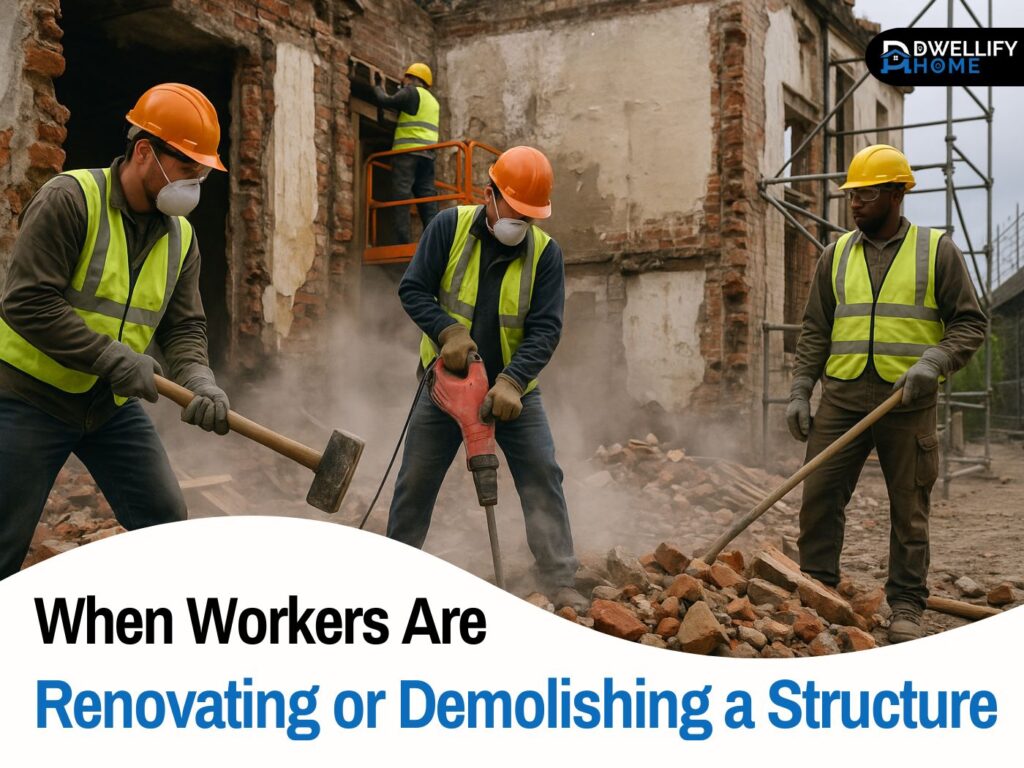If you’ve ever driven past a construction site and seen workers in helmets, masks, and bright vests surrounded by rubble and heavy machinery, you might’ve wondered — what exactly goes on when workers are renovating or demolishing a structure?
Here’s the thing: it’s not just about swinging hammers or knocking down walls. Every single step — from cutting the power to removing the last piece of debris — has to be carefully planned, inspected, and executed. One mistake can risk lives, cause costly damage, or even bring legal trouble.
As someone who’s been around construction and safety teams for years, trust me — these projects are serious business. So, let’s walk through what really happens behind the caution tape, and how professionals keep everyone safe when a building gets a second life or its final goodbye.
Snippet-Ready Definition:
When workers are renovating or demolishing a structure, they follow strict safety steps like de-energizing circuits, wearing PPE, and managing hazards to prevent accidents, electric shocks, and structural collapse.
Mission Statement:
Our mission is to promote safe, responsible, and sustainable construction practices by empowering workers, contractors, and homeowners with expert-backed knowledge about renovation and demolition safety. We believe every project — big or small — should protect lives, preserve the environment, and uphold industry excellence.
Understanding the Risks: Why Renovation and Demolition Are So Dangerous
Renovating or demolishing a structure is one of the riskiest jobs in construction. You’re dealing with old materials, unpredictable structures, and sometimes hidden hazards like asbestos or live electrical wires.
Unlike new construction, where everything starts fresh, old buildings come with secrets — unstable beams, corroded wiring, or weakened foundations. One wrong move and you could face structural collapse, electric shock, or hazardous dust exposure.
Here are the most common risks workers face:
- Electrical hazards: Old circuits may still be live, even if they look disconnected.
- Falls: Unprotected edges, scaffolds, or weakened floors pose huge dangers.
- Dust and debris: Renovations often release fine particles of silica, mold, or lead paint.
- Structural failure: Removing one beam without proper bracing can trigger a collapse.
- Toxic materials: Asbestos, lead, or chemicals hidden in old insulation or tiles.
I’ve seen teams spend days reinforcing walls or tracing utility lines before touching a single tool — because safety always comes first.
The Legal and Regulatory Side of Things
Before a single hammer hits a wall, every project goes through a web of rules. Renovation and demolition are tightly regulated by organizations like OSHA (Occupational Safety and Health Administration) and local building authorities.
These laws ensure that all safety protocols are followed — from proper PPE (Personal Protective Equipment) to hazardous energy control. OSHA’s demolition standards, for instance, require a full engineering survey before work begins to check for potential collapse risks.
Another key player? The “qualified person.” This is the safety expert responsible for identifying hazards and verifying that all energy sources — electrical, hydraulic, or mechanical — are properly isolated. If you’re wondering “what’s a qualified person responsible for during the equipment de-energizing process?” — this is it. They ensure no one gets shocked or hurt while equipment is being disconnected.
And yes, even something as small as a bathroom renovation in an older building can require permits and inspections. The paperwork might be a headache, but it’s what keeps everyone accountable and alive.
Before the Work Begins: Planning and Site Assessment
Every safe renovation or demolition starts with one thing: a solid plan.
Crews begin by conducting a site inspection — a deep look at the building’s structure, wiring, plumbing, and materials. They identify potential hazards like asbestos, unstable beams, or hidden gas lines. Then comes the risk assessment, where supervisors outline every possible danger and how to manage it.
Here’s what usually happens before the first hammer swings:
- Utility coordination: Contact local utility companies to disconnect power, gas, and water.
- Site security: Barricades and signage keep unauthorized people out.
- Sequence planning: Decide which parts to remove first to prevent collapse.
- Dust suppression setup: Plan misting systems or ventilation to control airborne particles.
I once worked with a crew that spent two full days just mapping underground utilities. Why? Because cutting through a live cable could’ve cost someone their life. That’s the level of caution professionals operate with.
De-Energizing and Lockout/Tagout: The First Step in Staying Alive
This part might sound technical, but it’s one of the most crucial safety steps.
De-energizing means making sure all electrical, hydraulic, or mechanical systems are completely off — and can’t accidentally turn back on.
Workers follow a strict process called Lockout/Tagout (LOTO). Here’s how it works:
- Identify all energy sources — electricity, gas, hydraulics, etc.
- Shut down the system safely.
- Apply locks and tags to switches and valves, so nobody reactivates them.
- Check for stored energy (like pressure or static charge).
- Test circuits to verify zero energy before touching any wire.
Now, here’s a question you might’ve seen in training: “What’s the first thing you have to do during the equipment de-energizing process?” The answer: identify and isolate all energy sources.
And guess what — even after locking everything, electricians use GFCIs (Ground Fault Circuit Interrupters) to detect any leakage current. It’s that extra layer of safety that can make all the difference.
Electrical Safety: Preventing Shocks and Fatal Mistakes
Electricity is silent, invisible, and deadly. A shock as small as 20 milliamps (mA) can paralyze muscles and stop breathing — and yes, that’s less than what a tiny bulb uses.
To stay safe, workers:
- Always wear insulated gloves and boots.
- Keep tools dry and rated for electrical work.
- Never touch two parts of a circuit at once (that’s how shocks happen).
- Use portable GFCI outlets on every power tool.
- Check that circuits are truly dead before cutting wires.
I’ve seen electricians double-check voltages even after full lockout — because trust me, you can never be “too sure” with electricity. That’s why OSHA requires all workers near electrical hazards to be trained and supervised by a qualified person.
Fall Protection: Staying Grounded at Dangerous Heights
Falls are the number one cause of construction injuries, and renovation or demolition sites make them even trickier.
Workers might be standing on weakened floors, unguarded ledges, or scaffolds several stories high.
Here’s how they stay safe:
- Use fall arrest systems — harnesses, safety nets, and lifelines.
- Install guardrails around open edges.
- Keep scaffolds stable and inspected daily.
- Secure ladders at the right angle and tie them off.
I remember a roofer telling me, “The moment you think you don’t need your harness is the day you fall.” That mindset — safety first, pride second — saves lives every day.
Handling Hazardous Materials: It’s Not Just Dust
Older buildings often hide dangerous substances — asbestos, lead paint, or chemical residues — that can harm workers and nearby residents.
Before demolition starts, certified inspectors test samples of insulation, tiles, and paint. If hazardous materials are found, specialized contractors handle the removal. They use sealed bags, air-tight suits, and negative-pressure rooms to prevent contamination.
Everything, from removal to disposal, follows strict regulations. Waste can’t just go to a landfill — it’s transported to approved facilities. Workers wear respirators, gloves, and disposable suits, and undergo decontamination before leaving the site.
It’s exhausting work, but the alternative — exposure to asbestos or lead — is far worse.
Personal Protective Equipment (PPE): The First Line of Defense
When workers are renovating or demolishing a structure, PPE isn’t optional — it’s survival gear.
Every task requires specific protection:
- Head & eye protection: Hard hats, goggles, face shields.
- Respiratory protection: Masks or filters for dust and fumes.
- Hearing protection: Earplugs or earmuffs for noisy machinery.
- Hand & foot protection: Gloves and steel-toe boots.
Supervisors make sure PPE fits properly and is checked daily. I’ve seen workers joke about “helmet hair,” but no one complains when that same helmet saves them from falling debris.
And yes, PPE gets uncomfortable in the heat, but it’s the reason people go home safe at night.
Keeping the Structure Standing: Bracing, Shoring, and Sequence Planning
Demolition isn’t just about tearing down — it’s about controlling the collapse. Before anything comes down, crews install temporary supports or shoring to hold the weight safely.
Work happens in a specific order, usually top-down, to prevent sudden collapse. Supervisors constantly check for cracks or shifting walls. If anything looks unstable, work stops immediately until it’s reinforced.
Think of it like removing Jenga blocks — take one wrong piece too soon, and everything comes crashing down. That’s why structural engineers are often on-site, monitoring every step.
Controlling Dust and Keeping the Air Clean
You’ve probably seen water spraying over a demolition site — that’s not just for show. It’s dust suppression in action.
Dust isn’t just messy; it can carry silica, asbestos, or lead, all of which are harmful to breathe.
So, workers use:
- Misting systems or hose sprays to keep dust down.
- Ventilation fans and air filters inside renovation areas.
- Dust barriers to isolate sections of a building.
Air quality monitors track airborne particles, ensuring they stay within safe limits. I’ve seen sites shut down mid-day when readings spike — because health always outweighs deadlines.
Waste, Debris, and Salvage: Managing the Aftermath
Once walls come down, the site fills with debris. But believe it or not, it’s not all waste — a lot of it can be reused or recycled.
Crews separate wood, concrete, metal, and glass for recycling. Reusable bricks or fixtures are salvaged for future projects. The rest is safely transported to approved disposal areas.
Waste management isn’t just eco-friendly; it keeps the site safer. Piles of debris can hide nails, wires, or sharp metal edges, so removal happens regularly to prevent accidents.
Training and Communication: The Human Element
Safety gear means nothing without safety culture. Workers receive regular training on equipment use, hazard recognition, and emergency response.
Daily “toolbox talks” are quick meetings before work begins — supervisors remind teams of the day’s risks and review any new hazards. Everyone, from laborers to engineers, has the right to stop work if something feels unsafe.
Here’s something I’ve learned: good communication saves lives. A worker once spotted a hairline crack in a column mid-shift — his quick call stopped the operation and probably prevented a collapse.
Inspection, Emergencies, and Real-Time Monitoring
Throughout a project, safety officers carry out constant inspections. They check that barricades are secure, PPE is being worn, and energy sources remain locked out.
Emergency procedures are also rehearsed — fire drills, collapse rescues, and electrical response plans. Workers know exactly where first-aid kits and exits are.
Some modern sites even use AI sensors and wearable tech that detect unsafe movements, vibrations, or toxic gases in real time. Technology is fast becoming construction’s silent guardian.
The Role of Technology and Innovation
Drones now help inspect rooftops, record progress, and spot unsafe conditions from above. Smart PPE can track worker movement and alert supervisors if someone falls or enters a danger zone.
Even AI-based systems analyze vibration data to predict when a structure might give way. It’s like having a digital safety officer watching over the crew 24/7.
These innovations don’t replace experience, but they make tough jobs a little safer — and that’s a huge win.
Environmental and Community Care
Renovation and demolition can affect neighbors too. Noise, vibration, and dust must be controlled. Crews set work hours, use quieter machinery, and keep communication open with local residents.
Proper waste and water management also protect nearby ecosystems. Every responsible contractor knows that a clean, respectful site earns trust — not complaints.
Expert Insights and Lessons Learned
Every experienced foreman has stories — close calls, smart saves, and moments that changed how they work.
One project I remember: a team found an unmarked live cable during demolition. Instead of cutting it, they stopped immediately, brought in an electrician, and discovered it powered the entire block. That pause saved the day.
The best workers aren’t just strong; they’re thoughtful. They follow rules, double-check, and look out for each other.
Insurance, Liability, and the Cost of Safety
Skipping safety steps might save a few hours, but the cost of an accident can bankrupt a project. Insurance claims, worker compensation, and fines for OSHA violations add up fast.
The good news? Companies with strong safety records often get better insurance rates and finish projects faster — because fewer accidents mean fewer delays. In construction, safety and profitability go hand in hand.
Step-by-Step Safety Guide: How Workers Stay Protected During Renovation or Demolition
| Step | Action | Purpose |
| 1. Site Inspection | Assess structure, utilities, and materials | Identify hidden hazards before work begins |
| 2. De-Energize Equipment | Disconnect power using Lockout/Tagout | Prevent electrical shocks or fires |
| 3. Secure the Area | Set up barriers, warning signs, and restricted zones | Keep unauthorized people away |
| 4. Wear Proper PPE | Helmets, gloves, respirators, safety boots | Protect against dust, debris, and falls |
| 5. Remove Hazardous Materials | Asbestos, lead, or chemicals | Avoid health and environmental risks |
| 6. Control Dust & Air Quality | Use misting, filters, and ventilation | Maintain safe breathing conditions |
| 7. Demolish in Sequence | Top-down or controlled removal | Prevent collapse or flying debris |
| 8. Dispose of Waste Safely | Recycle or send to approved facilities | Keep the site clean and eco-friendly |
Quick Comparison: Renovation vs Demolition
| Aspect | Renovation | Demolition |
| Purpose | Improve or restore existing structure | Completely remove old structure |
| Process | Selective repair and modification | Systematic teardown or implosion |
| Safety Focus | Worker protection and dust control | Structural collapse and debris management |
| End Result | Updated building | Cleared site for new construction |
Frequently Asked Questions
1. When workers are renovating or demolishing a structure, what procedure can prevent them from getting shocked by circuits that are part of the structure?
Workers use a Lockout/Tagout (LOTO) procedure to completely de-energize electrical circuits. It ensures all power sources are turned off, locked, and tested before work begins — preventing electric shocks or accidental reactivation.
2. What is the difference between renovation and demolition?
Renovation means improving, repairing, or updating an existing building. Demolition involves completely tearing it down. Both require safety inspections, permits, and trained professionals — but demolition demands extra precautions for collapse and debris.
3. What is Lockout and Tagout?
Lockout/Tagout (LOTO) is a safety method that isolates energy sources and locks equipment switches or valves. Tags are added to warn others not to reactivate the system until work is safely complete.
4. What measures should be taken to prevent an electrocution accident from occurring while performing construction work?
Workers should:
- Always de-energize circuits and confirm zero voltage.
- Use GFCIs for tools and power lines.
- Wear insulated PPE.
- Maintain safe distances from live wires.
- Follow OSHA electrical safety standards.
5. Why is PPE important during renovation or demolition work?
Personal Protective Equipment (PPE) shields workers from falling debris, dust, toxic materials, and electrical hazards. It’s the first defense against injuries and a must-have on every site.
Conclusion: Safety Isn’t Optional — It’s the Foundation
At the end of the day, when workers are renovating or demolishing a structure, it’s about more than just tearing down or rebuilding. It’s about protecting lives, respecting the craft, and doing it right.
Every bolt tightened, every wire checked, every helmet worn — it all adds up to one thing: going home safe.
So, the next time you pass a site and see workers carefully inspecting, spraying, or suiting up, remember — that’s what professionalism looks like. Behind every safe demolition or renovation are people who know one simple truth: there’s no shortcut to safety.
Disclaimer
This article is for educational and informational purposes only. Safety practices and legal requirements may vary by region. Always consult qualified professionals and follow OSHA or local authority regulations before starting renovation or demolition work. The author assumes no liability for any outcomes resulting from the use of this information.

I’m Bilal, the founder of Dwellify Home. With 6 years of practical experience in home remodeling, interior design, and décor consulting, I help people transform their spaces with simple, effective, and affordable ideas. I specialize in offering real-world tips, step-by-step guides, and product recommendations that make home improvement easier and more enjoyable. My mission is to empower homeowners and renters to create functional, beautiful spaces—one thoughtful update at a time.




